Butterbrot, the simple cold German sandwich and Brotzeit, the time(s) of the day when it is most frequently enjoyed are two culinary symbols steeped in tradition.
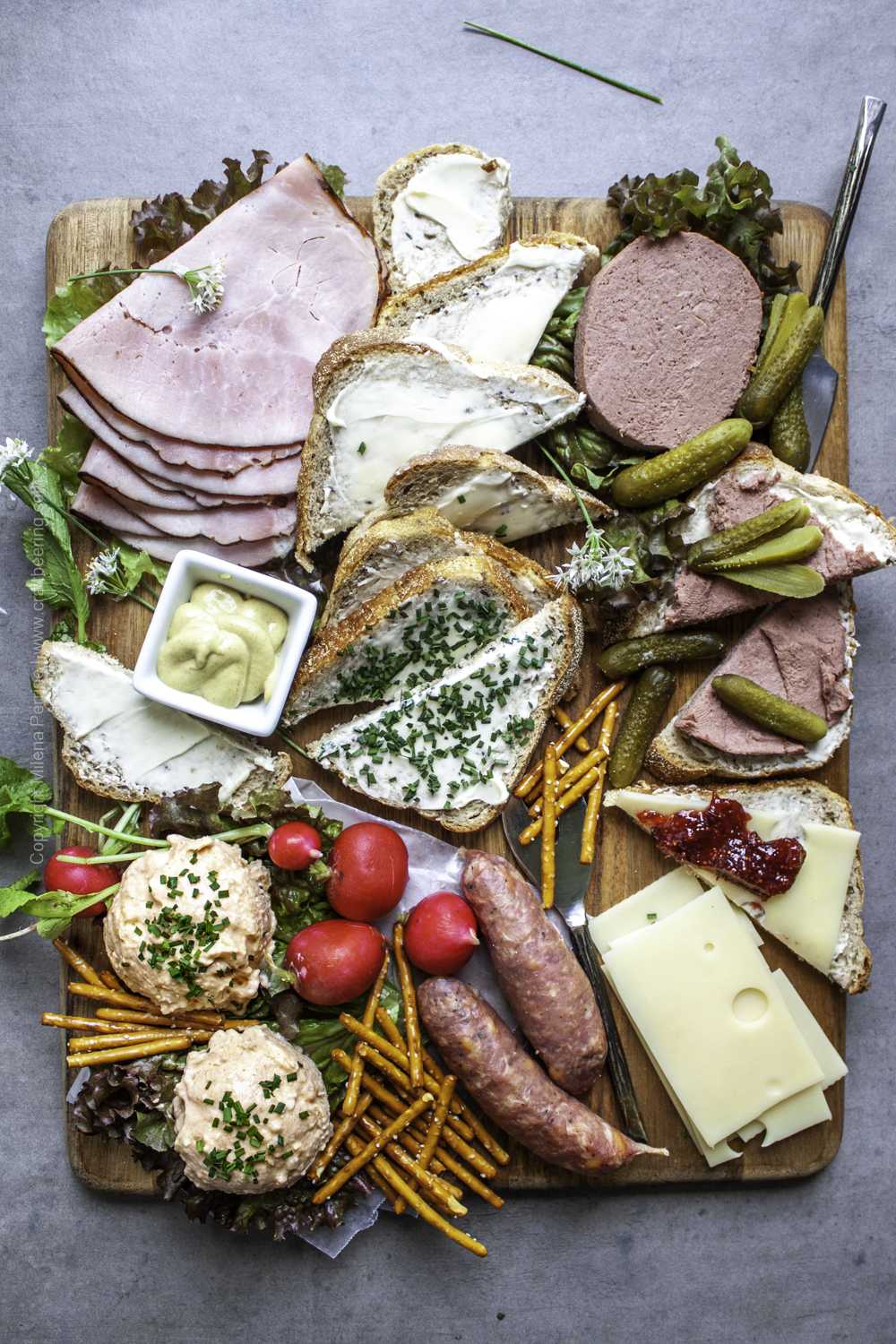
Go straight to the Brotzeit and Butterbrot Recipe Card or
Read on for background information and useful tips
What is Brotzeit?
Brotzeit translates to bread time from German and quite literally so: brot=bread, zeit=time. It is a snack type meal consisting of fresh bread, a variety of cold toppings and accompaniments and traditionally – beer, the other bread of Bavaria. It originated as a hearty snack eaten by farmers, shepards and field workers alike during their short breaks from doing demanding physical work.
Today Brotzeit is an established part of the cultural heritage of Bavaria and can be enjoyed at any time of the day – between breakfast and lunch, mid-afternoon, early evening etc. If it lasts a bit longer or is very susbtantial the next meal is simply skipped.
Typical Ingredients for the Brotzeit Platter
The Brotzeitplatte is typically presented on a wood board with all the ingredients arranged on top. This is in keeping with tradition – farmers and field workers didn’t snack from porcelain plates. The bread can be presented separately in a basket next to the other ingredients or directly on the platter. Butter is served with or near the bread.
Bread. Traditional bread choices are Farmer’s bread (a rye sourdough), and Bavarian pretzels. Brotchen (bread rolls) and bread sticks are more modern additions.
Meat/sausage. Cold meats such as smoked Black Forest ham or salami slices, precooked bratwurst (veal or veal & pork) and a variety of other types.
Cheese. Typically Emmental (type of Swiss cheese), Bavarian Blauschimmelkäse, Limburger, Butterkäse, Camembert, Bavarian Bergkäse.
Salads. Not what you expect! These hearty preparations of sausage or cheese are perfect with bread. The most popular examples are Wurstsalat (sausage salad, here is a recipe) and Limburger cheese salad (here is how to make it).
Dips/spreads/eggs. Obatzda, ham schmalz, apple and onion schmalz, quark dip, sweet Bavarian mustard, beer mustard, leberwurst, various savory butter spreads flavored with herbs, garlic, tomato etc. As much as the Bavarians love smoked trout and dips using it such as this one, fish is not included on Brotzeit platters. Hard boiled eggs or pickled eggs are also popular.
Veggies & herbs. Onions, radishes, Bavarian beer radish (lovingly called Radi and with a spicy attitude!), tomato (technically a fruit), cucumber or pickles, lettuce, chives, parsley.
Examples of Brotzeit Spreads
A very easy platter to prepare is the one pictured below, centered around the piquant beer cheese dip Obatzda. Soft Bavarain pretzels are a perfect companion for it. Use this recipe if you’d like to make your own.
Another wonderful spread can be built around snack-sized Frikadellen, such as pictured below, which can be consumed either warm or cold. These meatballs are a great pairing for both regular radishes and Munich Bierradi (you can substitute with daikon) and for buttered bread topped with chives, known as Schnitlauchbrott. Here is an authentic Frikadellen recipe and tips to prepare the pictured meal.
The German Sandwich known as Butterbrot
Butterbrot translates to butter(ed) bread from German. It is a simple open-faced sandwhich – a slice of bread, generously buttered and topped with savory or sweet ingredients. It is often enjoyed during Brotzeit although not exclusively, it can be a part of breakfast, lunch or accompany a cup of tea or coffee.
The origins of the buttered bread sandwich can be traced back to 1339 when in Bremen it was offered as an alternative to poridge. It slowly reached other parts of Germany and by the fifteenth century was accepted in Bavaria and was considered a healthy food to give to children. In the seventeenth century adding cheese slices to the Butterbrot became popular, followed by a variety of other toppings.
Today Butterbrot is declining in popularity but is still a widely enjoyed snack option in Germany, despite the availability of fast food and the nationwide trend to eat warm lunches over cold sandwiches.
Types of Butterbrot German Sanwiches
- Meat topped. All sorts of cold cuts from ham to wursts. Leberwurst is a delicious alternative (garnish with cucumber slices or gurken). Mett (raw minced pork) is also very popular in the Mettbrötchen (German raw pork sandwich).
- Cheese topped. Sliced or spreadable cheeses both work.
- Egg or veggie/herb topped. Hard boiled, scrambled or poached eggs and herbs like parsley and chives.
- Jam or chocolate topped. A favorite for breakfast – anything from strawberry jam to Nutella works here.
Covered Breads Open Faced German Sanwiches
Covered breads or belegte Brote in German are very similar, in fact nearly identical to butterbrot sandwhiches. They do not necessarily need to be buttered (mayo, cream cheese, mustard etc. can be used) and are frequently toasted. The toppings can be more creative and more modern, for example sauted shrimp or sauted mushrooms and onions.
The Beer Garden Connection
The origins of contemporary beer gardens are in the Free State of Bavaria (Freistaat Bayern), where the biergarten culture evolved into a phenomenon envied and replicated all over the world.
Back in the 1600’s beer brewing was restricted to the cold months of the year (October through March) due to the fire dangers posed by the extremely hot brewing kettles in hot weather. In those days without refrigeration the restriction meant that during summer when people craved cold, fresh beer the most, it was not available.
By way of solution to the flat, warm beer problem resourceful Bavarian brewers built cellars which they filled with blocks of ice sourced during the cold winters. They planted chestnut trees on top of these underground cellars to provide thick shade and thus the beer was granted cold storage all summer long. The chestnut trees doubled as inviting spots to sit under while enjoying a beer, a snack and a pleasant conversation – the beer garden was born.
In 1812 Maximilian I of Bavaria issued a proclamation allowing beer brewers to serve beer stored in their own cellars and bread during the summer months, but not any other kind of food. This layed the foundations of the custom of bringing one’s own food to the biergarten – something simple that could be enjoyed with bread (i.e. a Brotzeit platter or toppings for Butterbrot). To this day, the laws regulating beer gardens in Bavaria affirm that one thing that distinguishes a biergarten from an outdoor restaurant that serves beer is the fact that patrons can consume food they have brought along, free of charge.
Other Popular German Sandwiches
- Fischbrötchen. A popular fast food option around Germany. This sandwich consists of two freshly baked buns layered with fish such as meckerel, herring, sprat or salmon and garnished with onions, lettuce, pickles, remoulade or horseradish.
- Mettbrötchen. The German raw pork sandwich mentioned above is well loved and typically garnished with onion and parsley.
- Strammer Max. A slice of toasted rye bread or wheat bread, buttered and topped with ham and fried eggs. Flavored with mustard, salt and pepper.
- Leberkässemmel. Made up of two semmel halves (bread roll sliced in two) with a thick nicely browned slice of leberkäse in between. Typically served with mustard.
- Toast Hawaii. This open-faced German sandwich is simply a buttered slice of toast topped with ham, a slice of (typically canned) pineapple and a slice of Swiss or Gouda cheese. Broiled until the cheese melts and with a cocktail cherry as garnish.
You Might Enjoy
Beer Garden Pun Gift Idea
What is Oktoberfest?
Beer Braised Bavarian Bratwurst
Making Sense of Oktoberfest Beer Styles
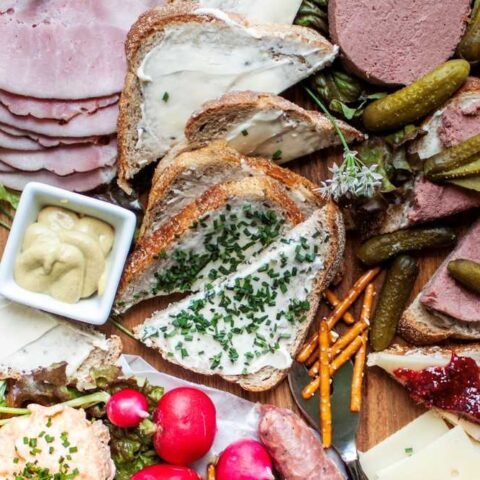
Butterbrot German Sandwiches & Brotzeit
How to build a brotzeit platter with a variety of ingredients suitable for cold Butterbrot sandwiches. The listed ingredients are offered as a suggestion - you do not need to have them all. Read the article for more ideas and to decide on the exact quantities and types of ingredients to use based on how many people you'd like to prepare Brotzeit food for. Be sure to have plenty of fresh German beer available as the drink of choice to accompany the meal.
Ingredients
- 20-30 slices of rye sourdough bread (German Farmer's bread)
- 10 soft Bavarian pretzels
- 10 tbsp butter*
- 10 slices of ham
- 10 pre-cooked Bavarian veal wursts or other type of sausage
- 20 oz cheese (choose among Emental, Limburger, Butterkase, Bavarian Bergkase, Camembert)
- 6 oz fruit preserve
- 6 oz leberwurst
- bunch red radishes, washed
- 1 daikon radish, spiraled
- 10 hard boiled or pickled eggs
- bunch chives
- flat leaf parsely, for garnish
- 1 red or sweet onion, sliced in circles, for garnish
- Bavarian sweet mustard or beer mustard
- 20 mini Frikadellen
- 10 hard boiled or pickled eggs, sliced
- tomato slices, to taste
- cucumber slices, to taste
- gurken, to taste
- 1/2 recipe Obatzda dip (see below for link)
- 1/2 recipe Wurstsalat (see below for link)
Instructions
- Arrange the ingredients you decided to use for your German sandwiches on a large wood board or similar platter. Place the bread and soft pretzels in a basket next to it or another platter. Serve the butter near the bread.
- To make the Butterbrot encourage guests to spread butter onto a slice of rye sourdough and then top with the ingredients of their choice.
Notes
*use a good quality European style butter
You can use these authentic recipes to create ingredients for your German sandwiches:
Nutrition Information:
Yield: 15 Serving Size: 1Amount Per Serving: Calories: 731Total Fat: 34gSaturated Fat: 16gTrans Fat: 1gUnsaturated Fat: 14gCholesterol: 370mgSodium: 1593mgCarbohydrates: 67gFiber: 6gSugar: 10gProtein: 38g
Nutritional information is based on ALL the ingredients listed. In all likelihood you will not be using them all.

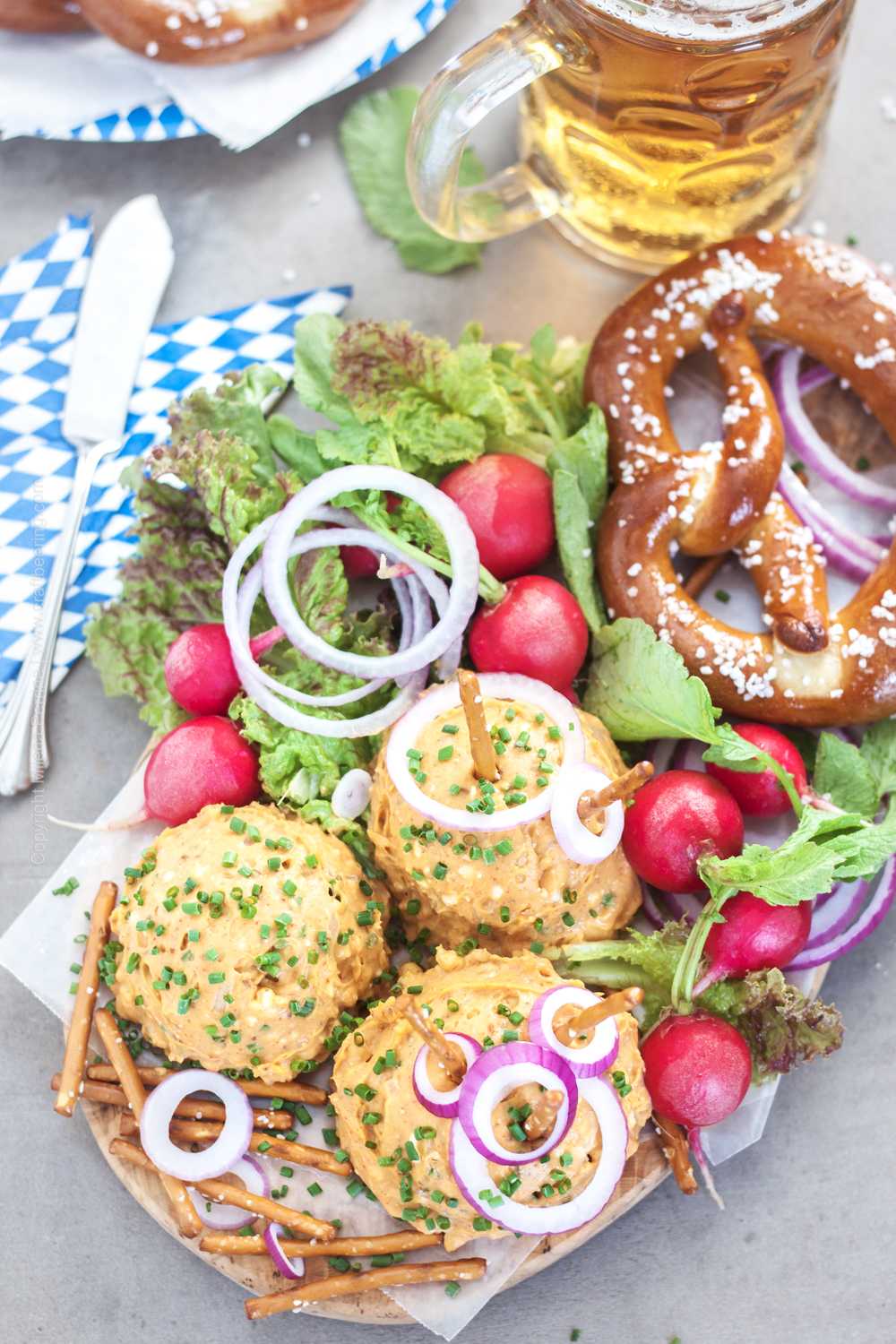
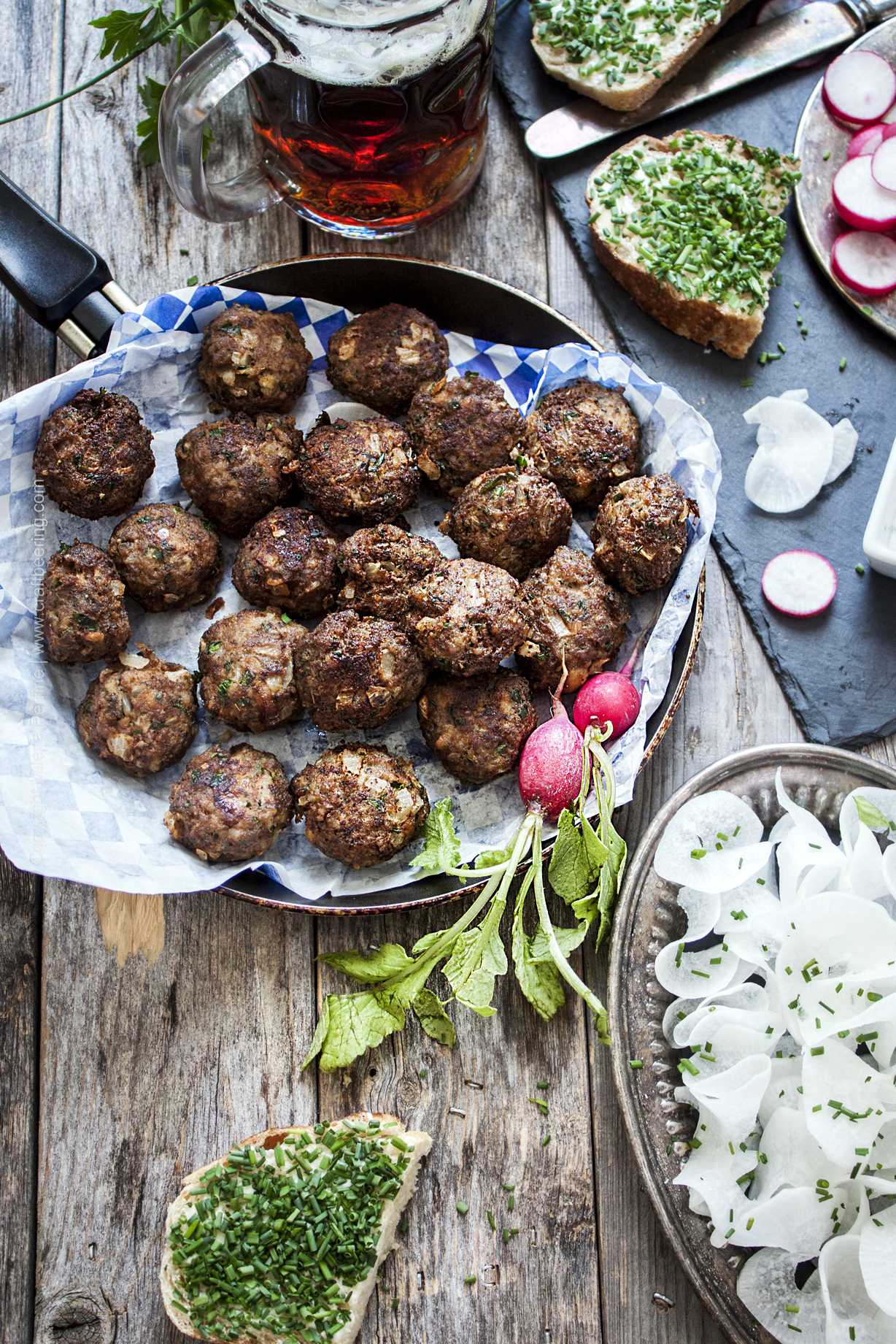
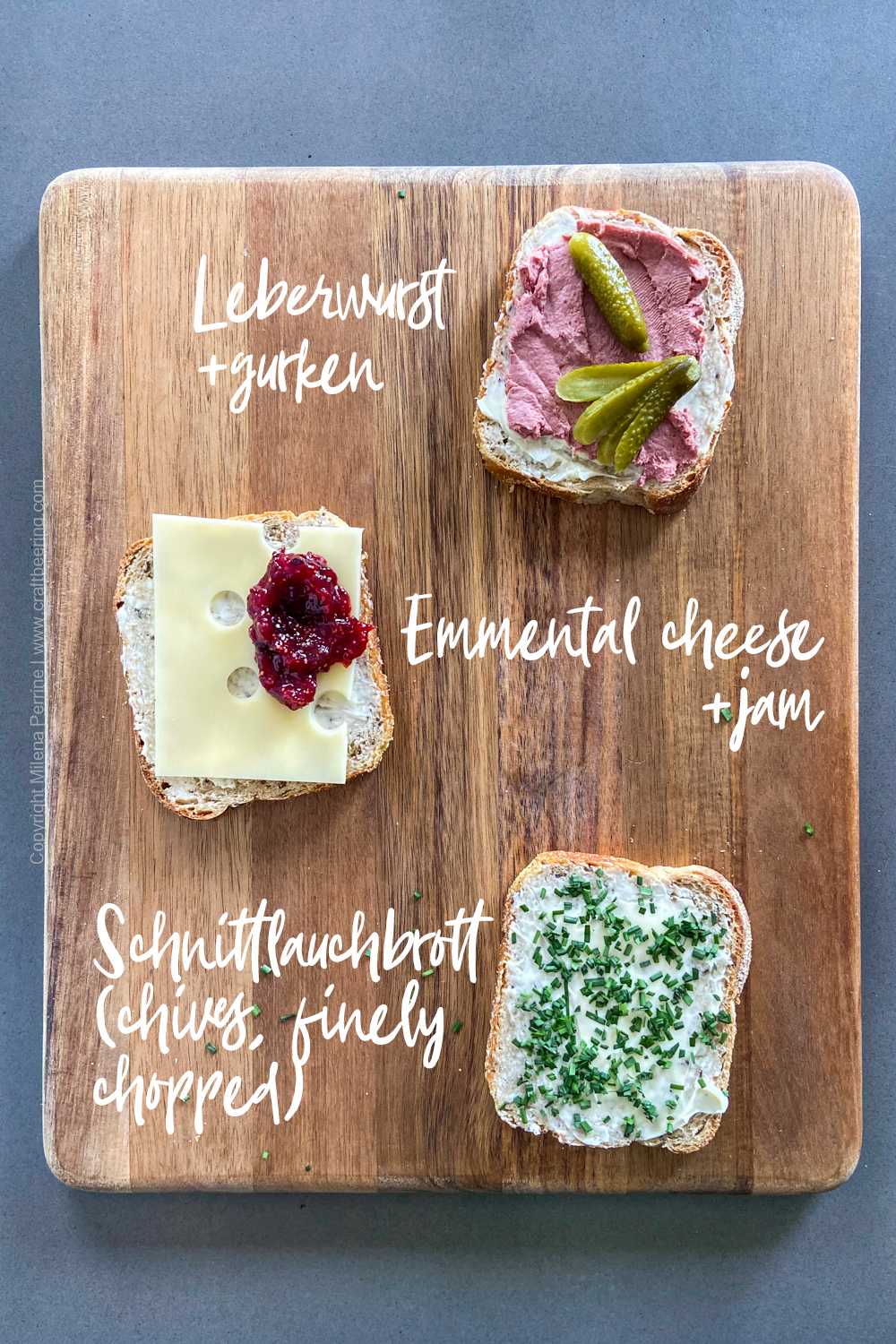
Leave a Reply